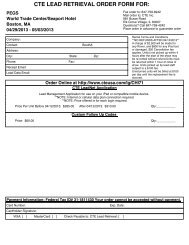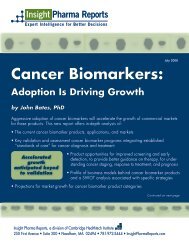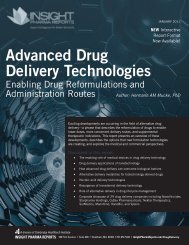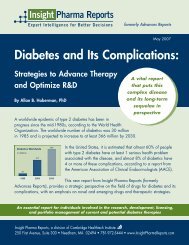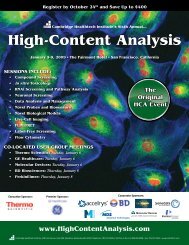2010 Best Practices Competition IT & Informatics HPC
IT Informatics - Cambridge Healthtech Institute
IT Informatics - Cambridge Healthtech Institute
- No tags were found...
You also want an ePaper? Increase the reach of your titles
YUMPU automatically turns print PDFs into web optimized ePapers that Google loves.
Published Resources for the Life Sciences<br />
250 First Avenue, Suite 300, Needham, MA 02494 | phone: 781‐972‐5400 | fax: 781‐972‐5425<br />
that assay performance and result normalization can generate meaningful values. Fourth,<br />
multiple vendors produce HCS readers and image analysis packages, along with thirdparty<br />
analysis packages such as CellProfiler 9 . Results and images must be converted to a<br />
common format so data and analysis tools can be shared between groups. Finally, HCS<br />
assays are inherently cell-based. Consistent identification of the cell lines, fluorescent<br />
dyes or antibody conjugates, and fluorescent proteins used in each assay is essential for<br />
the proper documentation and long-term mining of HCS results.<br />
To address these requirements we developed HCS Road, a data management system<br />
specifically designed for HCS. As the name indicates, HCS Road provides a smooth,<br />
well-defined route from image quantification to data analysis and reporting. The system<br />
combines an experiment definition tool, a relational database for results storage, assay<br />
performance reports, data normalization, and analysis capabilities. HCS Road currently<br />
supports multiple imaging platforms and provides a common repository for HCS data<br />
across instruments and user groups. In this work, we describe the approaches we took for<br />
data storage, experimental annotation, and data analysis and the scientific and business<br />
reasons for those decisions. We also present a XML schema for HCS data that supports<br />
multiple HCS platforms.<br />
RESULTS (highlight major R&D/<strong>IT</strong> tools deployed; innovative uses of technology).<br />
System Architecture<br />
Figure 1 shows an overview of the architecture of HCS Road. HCS Road currently<br />
supports three platforms: the Cellomics Arrayscan, the InCell 1000 (GE Healthcare,<br />
Parsippany, NJ), or the Evotec Opera. Images are analyzed with the appropriate software<br />
and the results are collected in platform-specific files or a platform database such as<br />
Cellomics Store. An HCS Road service converts data to a common XML format for<br />
import into the HCS Road database. Once the data is loaded into HCS Road it is merged<br />
with experimental annotation and treatment plate maps. Data import and merging can be<br />
performed manually or automatically based on previously registered plate barcodes. QC<br />
metrics and normalized results are calculated automatically and can be reviewed and<br />
analyzed using the HCS Road client or exported to third-party applications such as TIBCO<br />
Spotfire (TIBCO Software, Cambridge, MA).<br />
Users interact with HCS Road through two client applications. The Data Import<br />
application enables users to select plates for import from the platform-specific data<br />
repository (Cellomics database, Opera or InCell file share). Multiple plates can be



